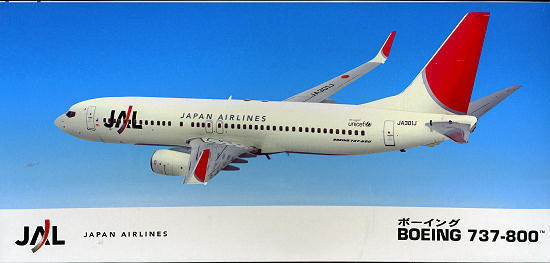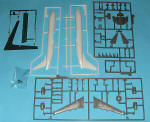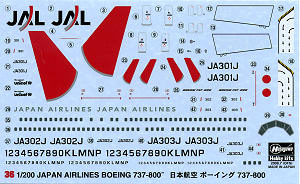
Hasegawa 1/200 Boeing 737- 800™
| KIT #: | 10736 |
| PRICE: | $24.95 MSRP |
| DECALS: | One option; three serials |
| REVIEWER: | Scott Van Aken |
| NOTES: |

| HISTORY |
IThe Boeing 737 is a short to medium range, single aisle, narrow body jet airliner. Originally developed as a shorter, lower cost twin engine airliner derived from Boeing's 707 and 727, the 737 has nine variants, from the early -100 to the most recent and largest, the -900. Currently series -600 through -900 are being produced.
First envisioned in 1964, the 737 entered service in 1968. Forty years later it has become the most ordered and produced commercial passenger jet in the world. It is Boeing's last surviving narrow-body airliner, sometimes serving markets previously filled by 707, 727, 757, DC-9 and MD-80/90 airliners. Continuously manufactured by Boeing since 1967 with over 8,000 ordered and over 5,800 delivered as of 2008, there are over 1,250 737s airborne at any given time. On average, a 737 departs or lands somewhere every five seconds.
The 737-800, and subject of this kit, is a stretched version of the 737-700, and replaces the 737-400. It also filled the gap left by Boeing's discontinuation of the McDonnell Douglas MD-80 and MD-90 after Boeing's merger with McDonnell Douglas. The -800 was launched by Hapag-Lloyd Flug (now TUIfly) in 1994 and entered service in 1998. The 737-800 seats 162 passengers in a two class layout, or 189 in one class, and competes with the A320. For many airlines in the U.S., the 737-800 replaced aging Boeing 727-200 trijets and McDonnell Douglas MD-80 and MD-90 series aircraft.
| THE KIT |
 Hasegawa
first issued its 'Loveliner' series of 1/200 airliners back in the late 1970s.
At the time, the aircraft had raised panel detail, open cabin windows, and
landing gear that could only be modeled in the 'down' position. This latter
feature required the modeler to expend considerable effort to do a wheels up
display, as often times main gear doors folded into each other when the gear was
down. As cabin window configuration was not always the same, it would require
the modeler to fill in those not needed. However, this was not a problem for a
number of modelers who liked this feature.
Hasegawa
first issued its 'Loveliner' series of 1/200 airliners back in the late 1970s.
At the time, the aircraft had raised panel detail, open cabin windows, and
landing gear that could only be modeled in the 'down' position. This latter
feature required the modeler to expend considerable effort to do a wheels up
display, as often times main gear doors folded into each other when the gear was
down. As cabin window configuration was not always the same, it would require
the modeler to fill in those not needed. However, this was not a problem for a
number of modelers who liked this feature.
This latest in the series has no cabin windows, optional 'wheels up' landing gear door parts, and fully engraved detailing. Things that are not changed are the lack of cockpit detail (generally not a problem for most), the inclusion of a display stand, and engines that will have a seam on the inside of the intake that is nearly impossible to remove. The only option that Hasegawa would have to fix this is to provide a single inlet ring that goes back past the fan. This would probably cause difficulty in blending in the seam, but it may be better than the way it is now. Many modelers will use resin replacements to alleviate this.
 Tail planes
are one piece and the wings have a lower insert that goes from inside the engine
pylons, across the lower fuselage to the other side. This section also has the
landing gear well, making for a sturdy construct. Thanks to the option for
wheels up, one can build this in flight. For ground use, a hefty screw is
provided to give the proper nose weight.
Tail planes
are one piece and the wings have a lower insert that goes from inside the engine
pylons, across the lower fuselage to the other side. This section also has the
landing gear well, making for a sturdy construct. Thanks to the option for
wheels up, one can build this in flight. For ground use, a hefty screw is
provided to give the proper nose weight.
Instructions are standard Hasegawa and use Gunze paint references. The planes are basically overall white with medium grey wings, tailplanes and lower fuselage. The decals are very nicely printed and allow one of three JAL aircraft. A variety of additional numbers and letters are given if you wish to do any others in the fleet. Of course, cabin and cockpit windows are included. The decals are the latest new wave type and should react favorably to setting solutions. The simple livery would make this an ideal first airliner for someone
| CONCLUSIONS |
Obviously these kits sell well. This one is superbly molded and at a Japanese price of 1600 yen, are a good buy in the home country. Thanks to the general simplicity of this one, I can recommend it even to the newest airliner modeler.
| REFERENCES |
September 2008
If you would like your product reviewed fairly and quickly, please contact me or see other details in the Note to Contributors.
Back to the Previews Index Page